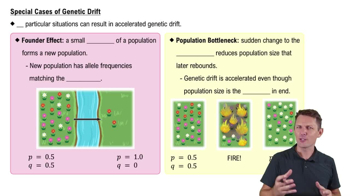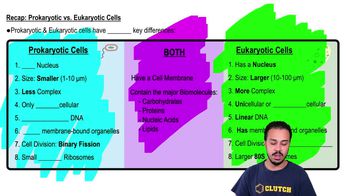Table of contents
- 1. Introduction to Biology2h 42m
- 2. Chemistry3h 40m
- 3. Water1h 26m
- 4. Biomolecules2h 23m
- 5. Cell Components2h 26m
- 6. The Membrane2h 31m
- 7. Energy and Metabolism2h 0m
- 8. Respiration2h 40m
- 9. Photosynthesis2h 49m
- 10. Cell Signaling59m
- 11. Cell Division2h 47m
- 12. Meiosis2h 0m
- 13. Mendelian Genetics4h 44m
- Introduction to Mendel's Experiments7m
- Genotype vs. Phenotype17m
- Punnett Squares13m
- Mendel's Experiments26m
- Mendel's Laws18m
- Monohybrid Crosses19m
- Test Crosses14m
- Dihybrid Crosses20m
- Punnett Square Probability26m
- Incomplete Dominance vs. Codominance20m
- Epistasis7m
- Non-Mendelian Genetics12m
- Pedigrees6m
- Autosomal Inheritance21m
- Sex-Linked Inheritance43m
- X-Inactivation9m
- 14. DNA Synthesis2h 27m
- 15. Gene Expression3h 20m
- 16. Regulation of Expression3h 31m
- Introduction to Regulation of Gene Expression13m
- Prokaryotic Gene Regulation via Operons27m
- The Lac Operon21m
- Glucose's Impact on Lac Operon25m
- The Trp Operon20m
- Review of the Lac Operon & Trp Operon11m
- Introduction to Eukaryotic Gene Regulation9m
- Eukaryotic Chromatin Modifications16m
- Eukaryotic Transcriptional Control22m
- Eukaryotic Post-Transcriptional Regulation28m
- Eukaryotic Post-Translational Regulation13m
- 17. Viruses37m
- 18. Biotechnology2h 58m
- 19. Genomics17m
- 20. Development1h 5m
- 21. Evolution3h 1m
- 22. Evolution of Populations3h 53m
- 23. Speciation1h 37m
- 24. History of Life on Earth2h 6m
- 25. Phylogeny2h 31m
- 26. Prokaryotes4h 59m
- 27. Protists1h 12m
- 28. Plants1h 22m
- 29. Fungi36m
- 30. Overview of Animals34m
- 31. Invertebrates1h 2m
- 32. Vertebrates50m
- 33. Plant Anatomy1h 3m
- 34. Vascular Plant Transport1h 2m
- 35. Soil37m
- 36. Plant Reproduction47m
- 37. Plant Sensation and Response1h 9m
- 38. Animal Form and Function1h 19m
- 39. Digestive System1h 10m
- 40. Circulatory System1h 49m
- 41. Immune System1h 12m
- 42. Osmoregulation and Excretion50m
- 43. Endocrine System1h 4m
- 44. Animal Reproduction1h 2m
- 45. Nervous System1h 55m
- 46. Sensory Systems46m
- 47. Muscle Systems23m
- 48. Ecology3h 11m
- Introduction to Ecology20m
- Biogeography14m
- Earth's Climate Patterns50m
- Introduction to Terrestrial Biomes10m
- Terrestrial Biomes: Near Equator13m
- Terrestrial Biomes: Temperate Regions10m
- Terrestrial Biomes: Northern Regions15m
- Introduction to Aquatic Biomes27m
- Freshwater Aquatic Biomes14m
- Marine Aquatic Biomes13m
- 49. Animal Behavior28m
- 50. Population Ecology3h 41m
- Introduction to Population Ecology28m
- Population Sampling Methods23m
- Life History12m
- Population Demography17m
- Factors Limiting Population Growth14m
- Introduction to Population Growth Models22m
- Linear Population Growth6m
- Exponential Population Growth29m
- Logistic Population Growth32m
- r/K Selection10m
- The Human Population22m
- 51. Community Ecology2h 46m
- Introduction to Community Ecology2m
- Introduction to Community Interactions9m
- Community Interactions: Competition (-/-)38m
- Community Interactions: Exploitation (+/-)23m
- Community Interactions: Mutualism (+/+) & Commensalism (+/0)9m
- Community Structure35m
- Community Dynamics26m
- Geographic Impact on Communities21m
- 52. Ecosystems2h 36m
- 53. Conservation Biology24m
16. Regulation of Expression
Introduction to Eukaryotic Gene Regulation
Problem 5
Textbook Question
The control of gene expression is more complex in multicellular eukaryotes than in prokaryotes because __________. (Explain your answer.)
a. Eukaryotic cells are much smaller
b. In a multicellular eukaryote, different cells are specialized for different functions
c. Prokaryotes are restricted to stable environments
d. Eukaryotes have fewer genes, so each gene must do several jobs
 Verified step by step guidance
Verified step by step guidance1
Understand the context of the question: Gene expression refers to the process by which information from a gene is used to synthesize functional gene products, such as proteins. The complexity of gene expression control can vary between prokaryotes and eukaryotes due to differences in their cellular organization and functions.
Analyze the options provided: Each option suggests a reason why gene expression might be more complex in multicellular eukaryotes. Evaluate each one based on biological principles.
Evaluate option a: 'Eukaryotic cells are much smaller.' This is incorrect because eukaryotic cells are generally larger than prokaryotic cells, and cell size does not directly influence the complexity of gene expression.
Evaluate option b: 'In a multicellular eukaryote, different cells are specialized for different functions.' This is correct because multicellular eukaryotes have specialized cells (e.g., muscle cells, nerve cells) that require precise and diverse gene expression patterns to perform their specific functions. This specialization adds complexity to gene regulation.
Evaluate options c and d: Option c ('Prokaryotes are restricted to stable environments') is incorrect because environmental stability does not directly relate to gene expression complexity. Option d ('Eukaryotes have fewer genes, so each gene must do several jobs') is also incorrect because eukaryotes generally have more genes than prokaryotes, and the complexity arises from regulatory mechanisms, not gene quantity.
 Verified video answer for a similar problem:
Verified video answer for a similar problem:This video solution was recommended by our tutors as helpful for the problem above
Video duration:
1mPlay a video:
Was this helpful?
Key Concepts
Here are the essential concepts you must grasp in order to answer the question correctly.
Gene Expression Regulation
Gene expression regulation refers to the mechanisms that control the timing, location, and amount of gene product (RNA or protein) produced in a cell. In multicellular eukaryotes, this regulation is complex due to the need for different cell types to express different genes based on their specialized functions, allowing for diverse physiological roles within the organism.
Recommended video:
Guided course

Introduction to Regulation of Gene Expression
Cell Specialization
Cell specialization, or differentiation, is the process by which generic cells develop into distinct cell types with specific functions. In multicellular eukaryotes, this specialization requires intricate regulatory networks to ensure that only the necessary genes are expressed in each cell type, contrasting with prokaryotes, where cells typically perform similar functions and express similar genes.
Recommended video:

Special Cases of Genetic Drift
Eukaryotic vs. Prokaryotic Gene Structure
Eukaryotic genes often contain introns and regulatory sequences that are not present in prokaryotic genes, which are generally simpler and organized in operons. This structural complexity in eukaryotes necessitates more sophisticated mechanisms for gene expression control, as multiple regulatory elements must coordinate to ensure proper gene function in response to developmental and environmental cues.
Recommended video:
Guided course

Recap: Prokaryotic vs. Eukaryotic Cells

 3:47m
3:47mWatch next
Master Introduction to Eukaryotic Gene Regulation with a bite sized video explanation from Jason
Start learningRelated Videos
Related Practice
Multiple Choice
The control of gene expression is more complex in multicellular eukaryotes than in prokaryotes because __________.
1036
views
